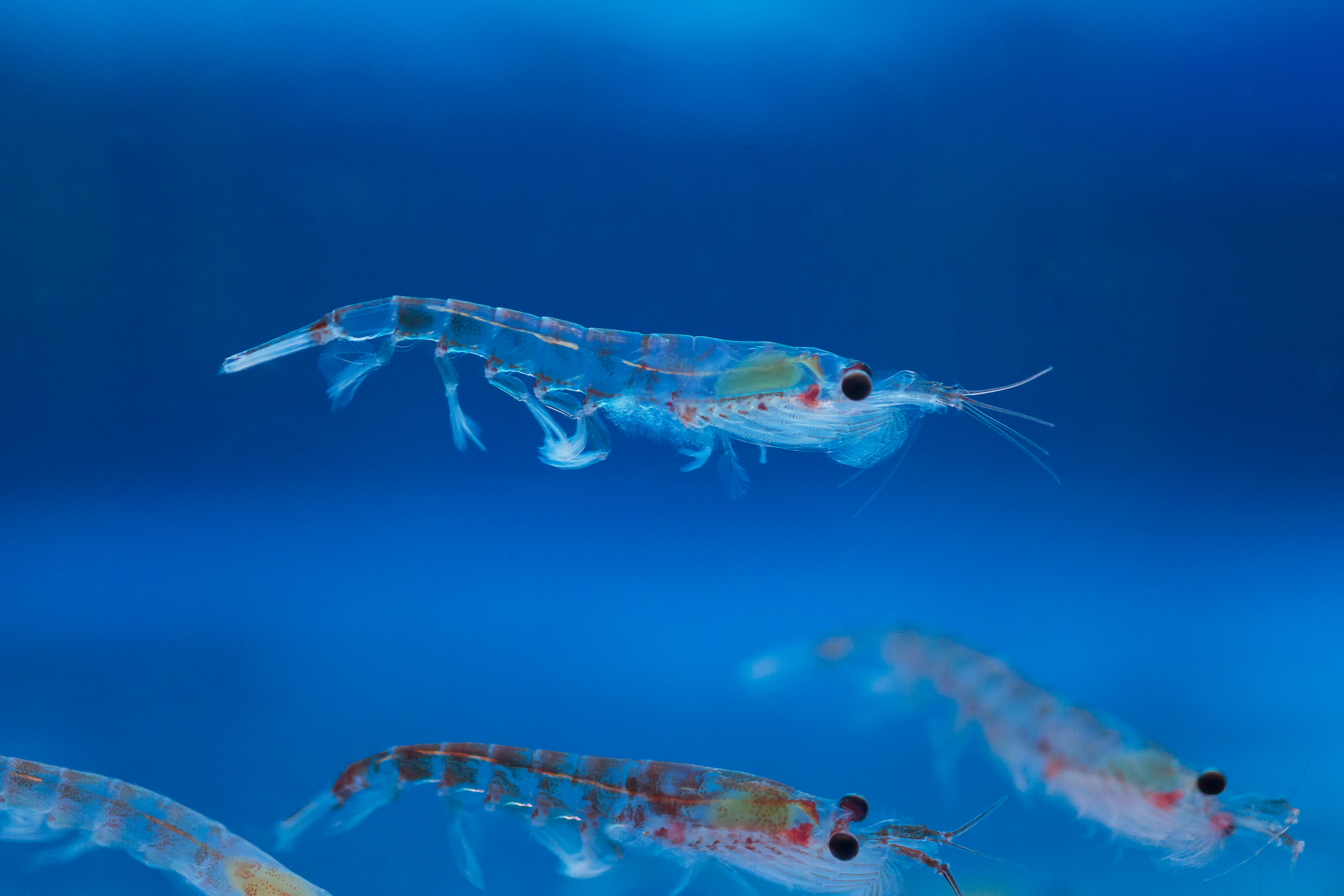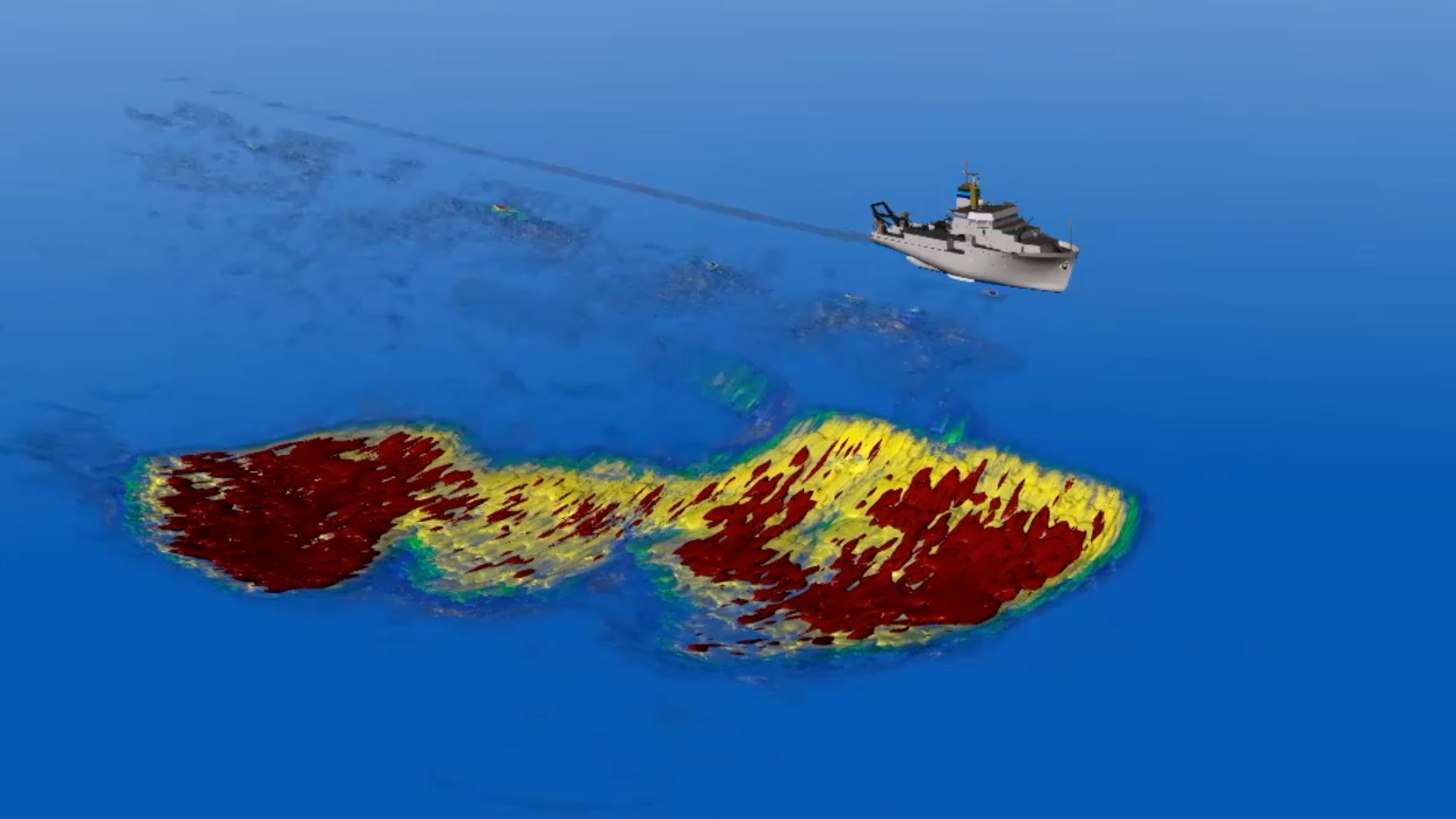
Antarctic krill, Euphausia superba (Photo: Brett Wilks)
For the first time on an Australian research vessel, giant krill swarms are being captured in 3D using state-of-the-art echosounder technology in the Southern Ocean.
A live krill swarm 400 metres long, 200 metres across, and 100 metres deep has been recorded by a team of Australian Antarctic Program scientists on board the CSIRO Marine National Facility research vessel Investigator.
The ENRICH* voyage is mid-way through its seven week expedition off the East Antarctic coast, following the calls of blue whales to find the krill swarms that they eat.

A 3D model of a live krill swarm 400 metres long, 200 metres wide, and 100 metres deep (Photo: Josh Lawrence/Australian Antarctic Division)
Krill biologist with the Australian Antarctic Division, Rob King, said krill is not only an individual animal, but also a super-organism.
“Krill swarms can be deep or shallow, dense or diffuse, but little is known about the different swarm types and whether some are more attractive to blue whales than others.”
“We’ve got so much more information available on this ship about the fine-scale three-dimensional structure of krill swarms that we can start to answer the question: what sort of krill is a blue whale after?” Mr King said.
Antarctic blue whales almost exclusively eat krill. In one day, an adult blue whale can eat up to 4 million krill, more than 3 tonnes. To do this, they must feed in areas where they can find high concentrations of krill.
Acoustician Joshua Lawrence of the Australian Antarctic Division is using the multibeam echosounders on RV Investigator to ‘paint a picture’ of the size, shape and density of krill swarms.
“With a three-dimensional model, you can really get to grips with the scale in terms of the depth and the size of the ship relative to the swarm.”
“We can contrast swarms where we’ve got whales, with swarms in areas where there aren’t any whales, to see what differences we can identify,” Mr Lawrence said.
“We’re collecting samples of krill from different swarms, to see if there’s any correlation between the three-dimensional structures we’re seeing and the krill’s size, age and population structure.”
Mr King said at this time of year, krill are in reproductive mode.
“What we’re seeing from the krill trawls so far is many female krill that are ready to lay eggs, and also a lot of trawls dominated by immature females.”
“It’s fascinating to be on a voyage where we target areas for krill research by listening in on blue whales that we’re hearing from hundreds of kilometres across the ocean,” Mr King said.
*ENRICH stands for ‘Euphausiids (krill) and Nutrient Recycling In Cetacean (whale) Hotspots’
This article was originally published by the Australian Antarctic Division. Find out more about this current voyage on their website.


19th February 2019 at 7:31 am
Really interesting research. Curious what is known of overall krill population numbers (and overall health: size, bodyweight, gender, etc.) in past season measurements and how they are fairing in today’s changing ocean conditions.
26th February 2019 at 1:10 pm
Dear James,
Thanks for the your question.
Antarctic krill (Euphausia superba) is one of 85 species of krill that lives in the Southern Ocean. Antarctic krill is one of the most abundant and successful animal species on Earth. Scientists estimate there could be up to 500 million tonnes of Antarctic krill in the Southern Ocean. The biomass of this one species may be the largest of any multicellular animal species on the planet. The current krill catch is less than 0.1 per cent of estimated global krill biomass.
Yours is a big question to answer. To make a start, you’ll find fairly up-to-date information at https://www.iucnredlist.org/species/64239743/64239951
More recent information here – http://www.antarctica.gov.au/magazine/2016-2020/issue-34-june-2018/science/what-have-we-learnt-about-krill
Kind regards,
CSIRO Social Media Team.
16th February 2019 at 6:21 pm
So let’s build super trawlers and catch them all…
15th February 2019 at 6:14 pm
Fascinating. It would be good to know how many individual krill are estimated to be in a swarm that size.
26th February 2019 at 1:11 pm
Dear Stuart,
Thanks for your question!
Some swarms can contain up to 30,000 individual krill per cubic metre, in parts. This swarm was estimated to contain 100-150 million krill.
Thanks,
CSIRO Social Media Team.